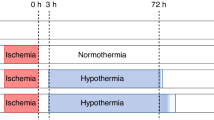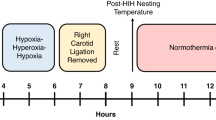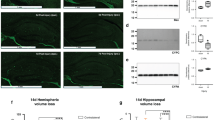Abstract
Background
Therapeutic hypothermia is partially protective for neonatal hypoxic–ischemic encephalopathy (HIE). Damage to the white matter tracts is highly associated with adverse outcomes after HIE, but the effectiveness and optimal duration of hypothermia to attenuate axonal injury are unclear.
Methods
Near-term fetal sheep were randomized to sham control or cerebral ischemia for 30 min with normothermia or cerebral hypothermia from 3 to either 48 or 72 h. Sheep were killed after 7 days. SMI-312-labeled axons and myelin basic protein were quantified in the intragyral white matter of the first and second parasagittal gyri.
Results
Ischemia was associated with reduced axonal and myelin area fraction (p < 0.05); loss of axonal and myelin linearity (p < 0.05); and thin, sparse axons, with spheroids, compared to dense, linear morphology in sham controls and associated with induction of microglia in an amoeboid morphology. Both ischemia–48 h hypothermia and ischemia–72 h hypothermia improved axonal area fraction and linearity (p < 0.05), although abnormal morphological features were seen in a subset. Microglial induction was partially suppressed by ischemia–48 h hypothermia, with a ramified morphology.
Conclusions
These data suggest that therapeutic hypothermia can alleviate post-ischemic axonopathy, in part by suppressing secondary inflammation.
Similar content being viewed by others
Log in or create a free account to read this content
Gain free access to this article, as well as selected content from this journal and more on nature.com
or
References
Jacobs, S. E. et al. Cooling for newborns with hypoxic ischaemic encephalopathy. Cochrane Database Syst. Rev. 1, CD003311 (2013).
Shankaran, S. Neonatal encephalopathy: treatment with hypothermia. J. Neurotrauma 26, 437–443 (2009).
Miller, S. P. et al. Patterns of brain injury in term neonatal encephalopathy. J. Pediatr. 146, 453–460 (2005).
Okereafor, A. et al. Patterns of brain injury in neonates exposed to perinatal sentinel events. Pediatrics 121, 906–914 (2008).
de Vries, L. S. & Groenendaal, F. Patterns of neonatal hypoxic-ischaemic brain injury. Neuroradiology 52, 555–566 (2010).
Rutherford, M. A. et al. Abnormal magnetic resonance signal in the internal capsule predicts poor neurodevelopmental outcome in infants with hypoxic-ischemic encephalopathy. Pediatrics 102, 323–328 (1998).
Hunt, R. W., Neil, J. J., Coleman, L. T., Kean, M. J. & Inder, T. E. Apparent diffusion coefficient in the posterior limb of the internal capsule predicts outcome after perinatal asphyxia. Pediatrics 114, 999–1003 (2004).
Haynes, R. L., Billiards, S. S., Borenstein, N. S., Volpe, J. J. & Kinney, H. C. Diffuse axonal injury in periventricular leukomalacia as determined by apoptotic marker fractin. Pediatr. Res. 63, 656–661 (2008).
Bell, J. E., Becher, J. C., Wyatt, B., Keeling, J. W. & McIntosh, N. Brain damage and axonal injury in a Scottish cohort of neonatal deaths. Brain 128, 1070–1081 (2005).
Riddle, A. et al. Differential susceptibility to axonopathy in necrotic and non-necrotic perinatal white matter injury. Stroke 43, 178–184 (2012).
Ohyu, J. et al. Early axonal and glial pathology in fetal sheep brains with leukomalacia induced by repeated umbilical cord occlusion. Brain Dev. 21, 248–252 (1999).
McIntosh, G. H., Baghurst, K. I., Potter, B. J. & Hetzel, B. S. Foetal brain development in the sheep. Neuropathol. Appl. Neurobiol. 5, 103–114 (1979).
Davidson, J. O. et al. How long is sufficient for optimal neuroprotection with cerebral cooling after ischemia in fetal sheep? J. Cereb. Blood Flow Metab. 38, 1047–1059 (2018).
Davidson, J. O. et al. Extending the duration of hypothermia does not further improve white matter protection after ischemia in term-equivalent fetal sheep. Sci. Rep. 6, 25178 (2016).
Kilkenny, C., Browne, W., Cuthill, I. C., Emerson, M. & Altman, D. G. Animal research: reporting in vivo experiments—the ARRIVE guidelines. J. Cereb. Blood Flow Metab. 31, 991–993 (2011).
Gunn, A. J., Gunn, T. R., de Haan, H. H., Williams, C. E. & Gluckman, P. D. Dramatic neuronal rescue with prolonged selective head cooling after ischemia in fetal lambs. J. Clin. Invest. 99, 248–256 (1997).
Rezakhaniha, R. et al. Experimental investigation of collagen waviness and orientation in the arterial adventitia using confocal laser scanning microscopy. Biomech. Model Mechanobiol. 11, 461–473 (2012).
Heursen, E. M. et al. Prognostic value of the apparent diffusion coefficient in newborns with hypoxic-ischaemic encephalopathy treated with therapeutic hypothermia. Neonatology 112, 67–72 (2017).
Drobyshevsky, A. et al. White matter injury correlates with hypertonia in an animal model of cerebral palsy. J. Cereb. Blood Flow Metab. 27, 270–281 (2007).
Meng, S. Z., Arai, Y., Deguchi, K. & Takashima, S. Early detection of axonal and neuronal lesions in prenatal-onset periventricular leukomalacia. Brain Dev. 19, 480–484 (1997).
Coleman, M. Axon degeneration mechanisms: commonality amid diversity. Nat. Rev. Neurosci. 6, 889–898 (2005).
Beirowski, B., Nogradi, A., Babetto, E., Garcia-Alias, G. & Coleman, M. P. Mechanisms of axonal spheroid formation in central nervous system Wallerian degeneration. J. Neuropathol. Exp. Neurol. 69, 455–472 (2010).
Haynes, R. L. et al. Axonal development in the cerebral white matter of the human fetus and infant. J. Comp. Neurol. 484, 156–167 (2005).
Mortazavi, F. et al. Geometric navigation of axons in a cerebral pathway: comparing dMRI with tract tracing and immunohistochemistry. Cereb. Cortex 28, 1219–1232 (2018).
Su, K. G., Banker, G., Bourdette, D. & Forte, M. Axonal degeneration in multiple sclerosis: the mitochondrial hypothesis. Curr. Neurol. Neurosci. Rep. 9, 411–417 (2009).
Saxena, S. & Caroni, P. Mechanisms of axon degeneration: from development to disease. Prog. Neurobiol. 83, 174–191 (2007).
Brambrink, A. M. et al. Isoflurane-induced apoptosis of oligodendrocytes in the neonatal primate brain. Ann. Neurol. 72, 525–535 (2012).
Tricaud, N. & Park, H. T. Wallerian demyelination: chronicle of a cellular cataclysm. Cell. Mol. Life Sci. 74, 4049–4057 (2017).
di Penta, A. et al. Oxidative stress and proinflammatory cytokines contribute to demyelination and axonal damage in a cerebellar culture model of neuroinflammation. PLoS ONE 8, e54722 (2013).
Denker, S. P. et al. Macrophages are comprised of resident brain microglia not infiltrating peripheral monocytes acutely after neonatal stroke. J. Neurochem. 100, 893–904 (2007).
Ferrazzano, P. et al. Age-dependent microglial activation in immature brains after hypoxia- ischemia. CNS Neurol. Disord. Drug Targets 12, 338–349 (2013).
Wassink, G. et al. A working model for hypothermic neuroprotection. J. Physiol. 596, 5641–5654 (2018).
Zhou, K. Q., Green, C. R., Bennet, L., Gunn, A. J. & Davidson, J. O. The role of connexin and pannexin channels in perinatal brain injury and inflammation. Front. Physiol. 10, 141 (2019).
Cusack, C. L., Swahari, V., Hampton Henley, W., Michael Ramsey, J. & Deshmukh, M. Distinct pathways mediate axon degeneration during apoptosis and axon-specific pruning. Nat. Commun. 4, 1876 (2013).
Ohmura, A. et al. Prolonged hypothermia protects neonatal rat brain against hypoxic-ischemia by reducing both apoptosis and necrosis. Brain Dev. 27, 517–526 (2005).
Roelfsema, V. et al. Window of opportunity of cerebral hypothermia for postischemic white matter injury in the near-term fetal sheep. J. Cereb. Blood Flow Metab. 24, 877–886 (2004).
Davidson J. O., Battin M., Gunn A. J. Evidence that therapeutic hypothermia should be continued for 72 h. Arch. Dis. Child. Fetal Neonatal Ed. 104, F225 (2019).
Fleiss, B. & Gressens, P. Tertiary mechanisms of brain damage: a new hope for treatment of cerebral palsy? Lancet Neurol. 11, 556–566 (2012).
Edwards, A. D. et al. Neurological outcomes at 18 months of age after moderate hypothermia for perinatal hypoxic ischaemic encephalopathy: synthesis and meta-analysis of trial data. BMJ 340, c363 (2010).
Guillet, R. et al. Seven- to eight-year follow-up of the CoolCap trial of head cooling for neonatal encephalopathy. Pediatr. Res. 71, 205–209 (2012).
Azzopardi, D. et al. Effects of hypothermia for perinatal asphyxia on childhood outcomes. N. Engl. J. Med. 371, 140–149 (2014).
Natarajan, G., Pappas, A. & Shankaran, S. Outcomes in childhood following therapeutic hypothermia for neonatal hypoxic-ischemic encephalopathy (HIE). Semin. Perinatol. 40, 549–555 (2016).
Acknowledgements
This study was funded by The Health Research Council of New Zealand (grant numbers: 16/003, 17/601) and the Marsden Fund (grant number: 17-UOA232). J.O.D. holds a Sir Charles Hercus Fellowship from the Health Research Council of New Zealand (16/003). K.Q.Z. was supported by a University of Auckland Doctoral Scholarship.
Author information
Authors and Affiliations
Contributions
K.Q.Z., L.B., A.J.G., and J.O.D. conceptualized and designed the study. J.O.D. undertook experiments. K.Q.Z., V.D., C.A.L., J.L.A., and Y.H. developed linearity analysis. K.Q.Z., V.D., and J.M.D. contributed to immunohistochemistry and microscopy. K.Q.Z. conducted data analysis, preparation of figures, and drafted the manuscript. All authors approved the final version of the manuscript.
Corresponding author
Ethics declarations
Competing interests
The authors declare no competing interests.
Additional information
Publisher’s note: Springer Nature remains neutral with regard to jurisdictional claims in published maps and institutional affiliations.
Supplementary information
Rights and permissions
About this article
Cite this article
Zhou, K.Q., Draghi, V., Lear, C.A. et al. Protection of axonal integrity with 48 or 72 h of cerebral hypothermia in near-term fetal sheep. Pediatr Res 88, 48–56 (2020). https://doi.org/10.1038/s41390-019-0475-8
Received:
Revised:
Accepted:
Published:
Issue date:
DOI: https://doi.org/10.1038/s41390-019-0475-8
This article is cited by
-
Slow rewarming after hypothermia does not ameliorate white matter injury after hypoxia-ischemia in near-term fetal sheep
Pediatric Research (2025)
-
Persistent cortical and white matter inflammation after therapeutic hypothermia for ischemia in near-term fetal sheep
Journal of Neuroinflammation (2022)
-
Magnesium sulfate: a last roll of the dice for anti-excitotoxicity?
Pediatric Research (2019)



